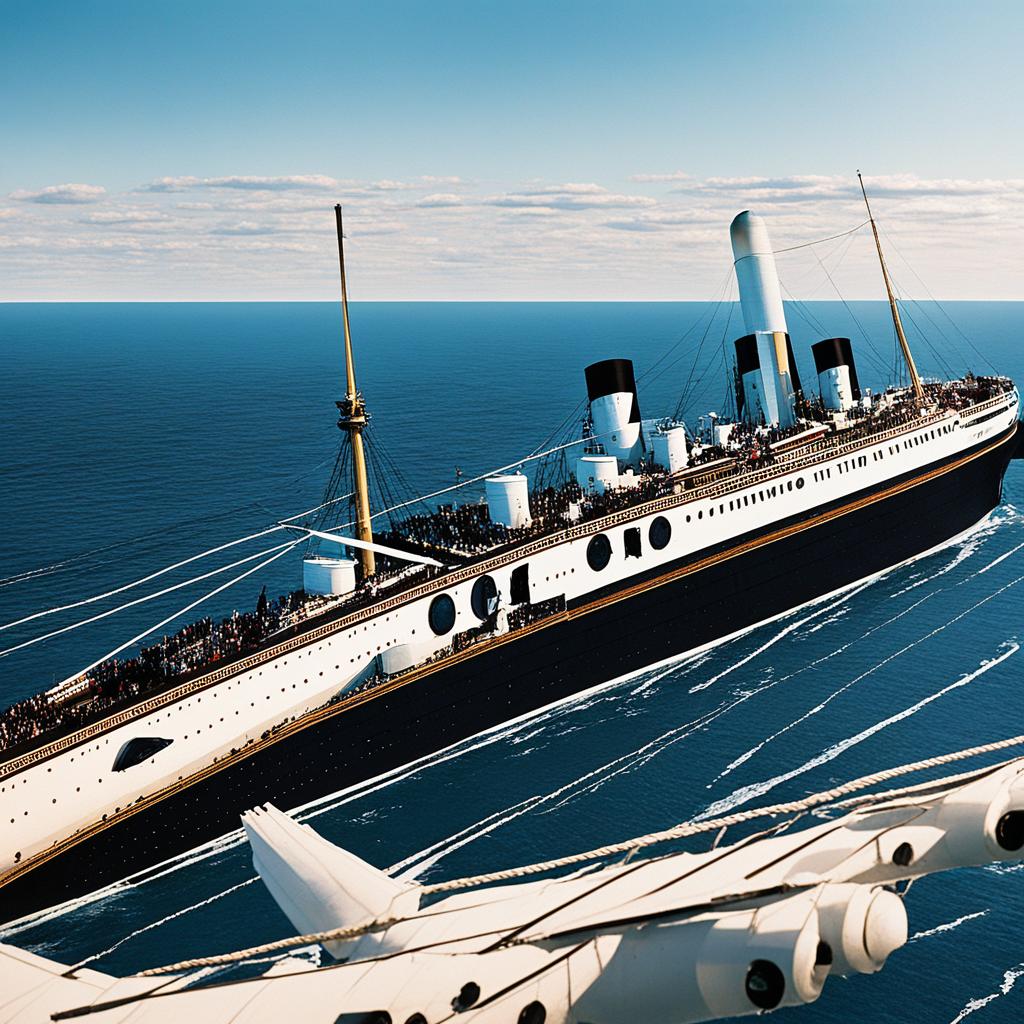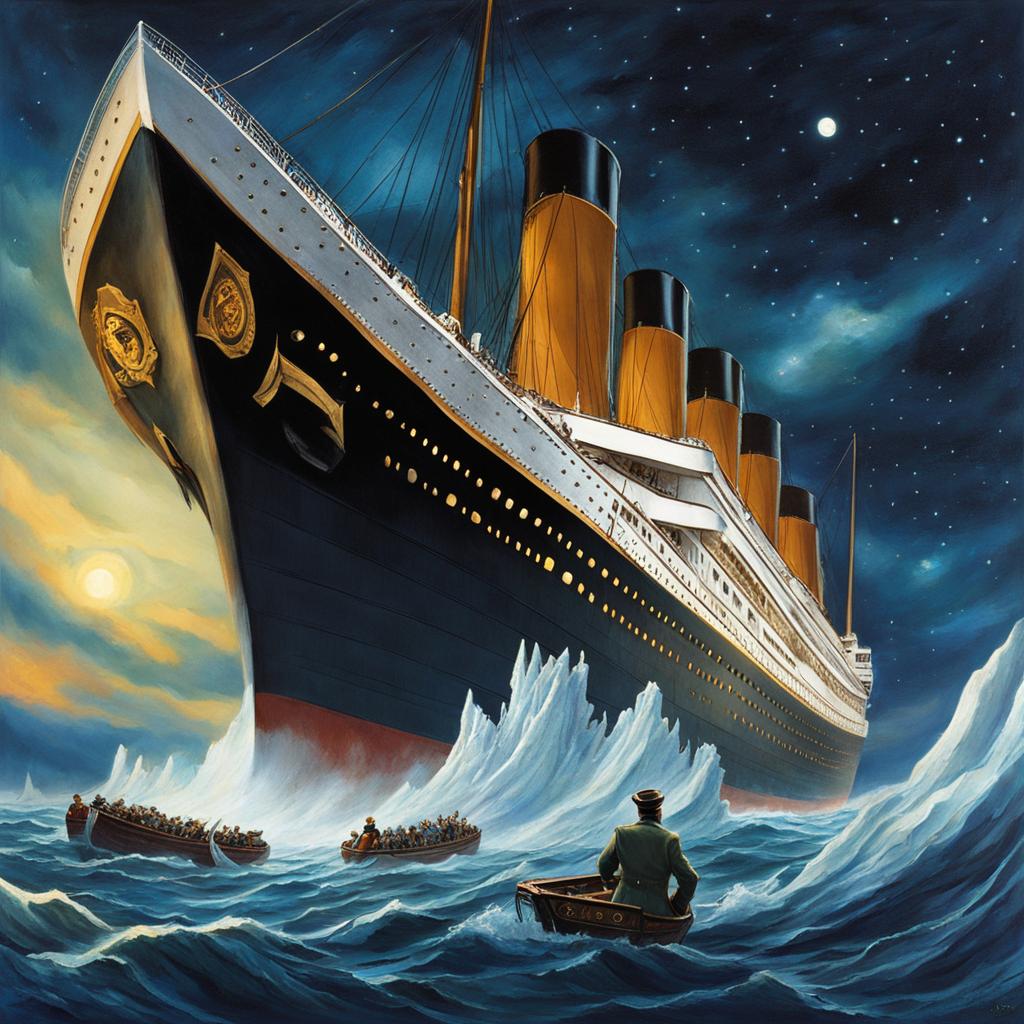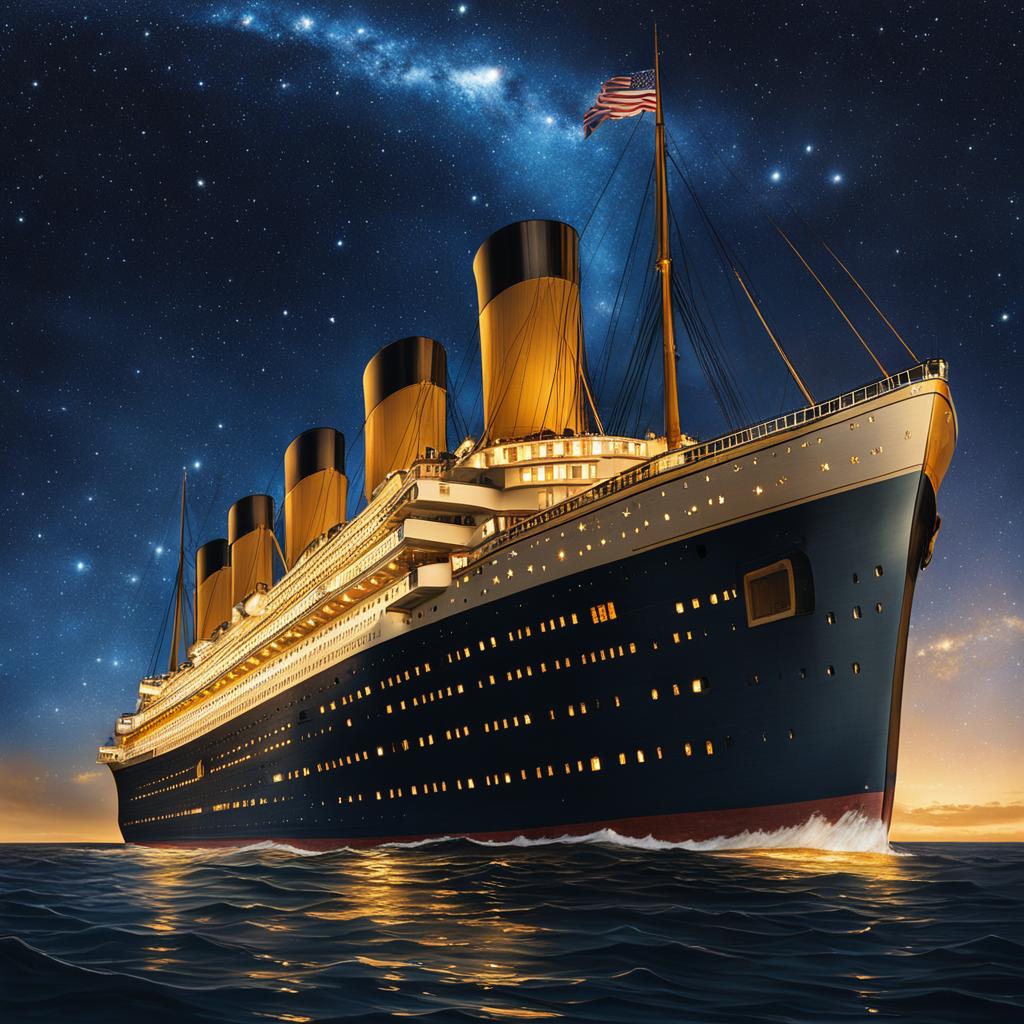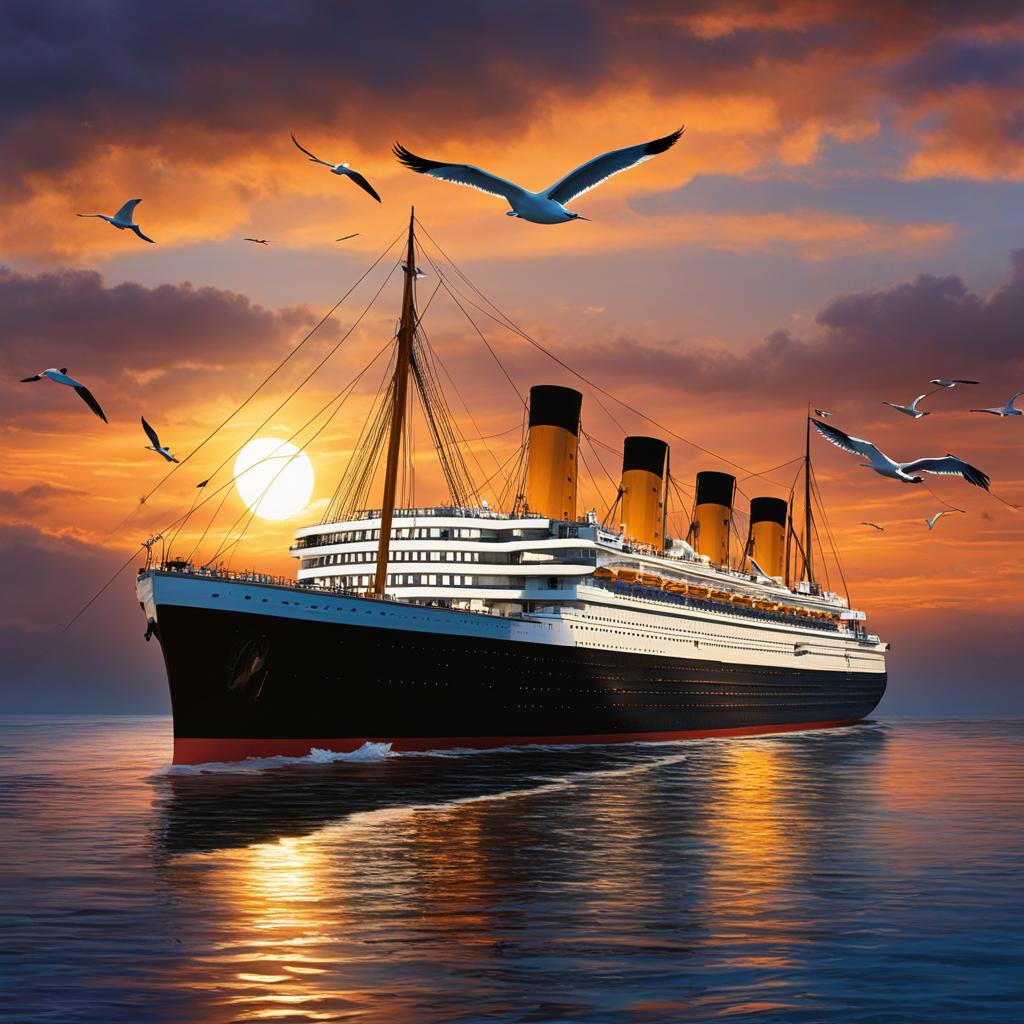The alternate history scenario of what if the Titanic never sank is a fascinating concept to explore. By considering different possibilities and examining the potential impact on maritime history and culture, we can gain new insights into one of the most tragic disasters of the 20th century.
Key Takeaways:
- The hypothetical scenario of the Titanic never sinking opens up new avenues for exploring the impact it could have had on maritime history.
- Examining alternative endings and what could have happened if the Titanic survived allows for a deeper understanding of the tragedy.
- Considering the role of binoculars and alternative scenarios for avoiding the collision brings interesting insights to light.
- The potential impact on maritime regulations and safety measures cannot be overlooked if the Titanic had survived.
- The fate of the Titanic and its sister ships in the alternate scenario offers a glimpse into a different timeline of maritime history.
The Role of Binoculars in Avoiding the Collision

While it is generally believed that binoculars wouldn’t have played a significant role in avoiding the titanic collision with the iceberg, they were not relied upon heavily by the lookouts. The officers on the bridge maintained their own watch and considered the lookouts as a backup. However, the use of binoculars by the officer in charge, officer Murdoch, could have potentially made a difference in avoiding the collision if he had been able to spot the iceberg just a few seconds earlier.
The lookout watch was an essential part of Titanic’s safety precautions, but the focus was primarily on visual observations without the aid of binoculars. The lookouts were tasked with scanning the horizon for any potential obstacles that might be in the ship’s path, such as icebergs. They used their naked eyes to spot these hazards and alert the bridge officers in a timely manner.
The lack of binoculars for the lookouts has been a topic of discussion and speculation over the years. However, it is important to note that binoculars were not seen as essential equipment for the lookouts during that time period. The prevailing belief was that the naked eye was sufficient for detecting potential hazards, and binoculars were more commonly used for navigation purposes rather than lookout duties.
The Responsibility of Officer Murdoch
Officer William Murdoch, as the officer in charge on the bridge, held significant responsibility for the safe navigation of the Titanic. While the use of binoculars might not have been a standard practice for the lookouts, giving Officer Murdoch an extra few seconds to spot the iceberg could have potentially made a difference in avoiding the collision.
| Role | Responsibility | |
|---|---|---|
| Officer Murdoch | Officer in Charge | Overall navigation and decision-making |
| Lookouts | Backup Vigilance | Primary watch for potential hazards |
Potential Alternate Scenarios for Avoiding the Collision

To avoid the collision, several potential alternate scenarios could be considered. These alternative scenarios involve altering course or timing to prevent the Titanic from colliding with the iceberg. By exploring these possibilities, we can gain a better understanding of the factors that could have led to a different outcome.
Moving the Iceberg
An intriguing alternative scenario involves moving the iceberg itself slightly to the north. If it were possible to shift the iceberg’s position, even by a small distance, the Titanic could have passed safely without a collision. This hypothetical solution relies on manipulating the natural environment and altering the iceberg’s trajectory to avoid disaster.
Altering the Titanic’s Course
Another potential scenario for avoiding the collision involves slightly altering the Titanic’s course to the south. By making a small adjustment to the ship’s trajectory, it could have steered clear of the iceberg’s path. This scenario depends on precise navigation and real-time adjustments to ensure the ship safely bypasses the iceberg.
Evaluating Lookout Timing
Timing played a crucial role in the Titanic’s collision with the iceberg. An alternate scenario could involve the lookouts or the officer on deck spotting the iceberg a little sooner. By spotting the iceberg earlier, the crew could have taken swift action to avoid a collision, such as altering course or slowing down the ship. This scenario highlights the importance of effective lookout timing and the significance of being proactive in preventing accidents.
Exploring these potential alternate scenarios offers insight into the various factors that could have influenced the outcome of the Titanic’s voyage. While they remain speculative, they demonstrate the potential for alternative outcomes when considering small adjustments in timing, positioning, and decision-making.
The Impact of Titanic Surviving on Maritime History
If the Titanic had survived, it would have likely been involved in some other accident due to the lack of sufficient lifeboats. However, the impact of this hypothetical accident might not have had the same profound effect as the sinking of the Titanic. The sinking of the Titanic served as a significant symbol of the end of an era and highlighted the need for improved safety regulations in maritime history. The extended time it took for the Titanic to sink also allowed for real human drama to unfold and nearly all the lifeboats to be launched.
End-of-an-Era Effect
The sinking of the Titanic marked the end of an era that romanticized the grandeur and invincibility of luxury liners. It shattered the illusion of unsinkable ships and emphasized the vulnerability of even the most advanced vessels. The Titanic disaster prompted a paradigm shift in maritime safety regulations, with stricter laws and protocols implemented to prevent future tragedies.
Lifeboats and Time to Launch
One of the key aspects that showcased the impact of the Titanic’s sinking was the scarcity of lifeboats and the limited time available to launch them. The ill-preparedness of the Titanic highlighted the need for sufficient lifeboats on all ships to ensure the safety of passengers and crew in the event of an emergency. The prolonged sinking process allowed for a harrowing human drama, with desperate attempts to launch the limited number of lifeboats and save as many lives as possible.
| Impact | Description |
|---|---|
| End of an era | The sinking of the Titanic marked the end of the era of lavish and overconfident luxury liners, leading to a reassessment of safety standards in maritime history. |
| Awareness for lifeboats | The scarcity of lifeboats and the need for an adequate number of them on all ships gained significant attention after the Titanic’s sinking. |
| Human drama | The extended sinking time of the Titanic allowed for real-life human dramas to unfold, heightening the tragedy and capturing public imagination. |
The Fate of the Titanic in the Following Years

If the Titanic had survived, it would likely have had a lifespan of around 25 to 30 years before meeting the same fate as other vessels from that era – the scrapyard. The Titanic would have lost its status as the world’s largest liner within a year, with the completion of the RMS Aquitania and SS Imperator. During World War I, the Titanic would have been pressed into service as either a troop transport or a hospital ship, playing a crucial role in the war effort.
The Titanic’s Lifespan
If the Titanic had survived its fateful voyage, it would have had an expected lifespan of approximately 25 to 30 years. However, like many other ocean liners of its time, the Titanic’s fate would ultimately lead it to the scrapyard.
The Completion of RMS Aquitania and SS Imperator
Despite its initial status as the world’s largest liner, the Titanic would soon lose that title. Within a year of its survival, the RMS Aquitania and SS Imperator would have been completed, surpassing the Titanic in size and luxury.
Role in World War I
During World War I, the Titanic would have been vital to the war effort. Given its size and capacity, it would have been repurposed as either a troop transport or a hospital ship. In this role, the Titanic would have played a significant part in the transportation of troops or as a floating medical facility.
Post-War Service and Modernization
Following the conclusion of the war, the RMS Titanic would have returned to civilian service and undergone a comprehensive modernization refit in 1918. This refit would have entailed significant changes to enhance the ship’s capabilities and extend its lifespan.
The post-war modernization of the Titanic would have included various interior upgrades to enhance passenger comfort and luxury. Additional staterooms would have been added to accommodate the growing demand for transatlantic travel. These enhancements would have solidified the Titanic’s status as a premier vessel for passenger and tourist transportation.
One of the most significant changes during the modernization refit would have been the conversion of the Titanic’s propulsion system. The ship would have transitioned from burning coal to using oil as fuel. This shift would have resulted in improved efficiency and reduced pollution, aligning with the industry’s trend towards more sustainable practices.
This modernization refit would have positioned the Titanic to regain its status as the largest British liner afloat, surpassing its contemporaries like the SS Imperator. The technological advancements and updated amenities would have appealed to passengers seeking the ultimate luxury experience.
Throughout the 1920s, the post-war Titanic would have continued operating as a sought-after vessel for transatlantic voyages. Its refined features, coupled with its historical significance, would have made it a preferred choice among travelers.
Here is a comprehensive overview of the post-war service and modernization of the RMS Titanic:
| Post-War Service and Modernization | Key Details |
|---|---|
| Service Resumption | Returned to civilian service after the war |
| Modernization Refit | Completed in 1918 |
| Interior Upgrades | Included additional staterooms for passenger comfort |
| Conversion to Oil Burning | Transitioned from coal to oil as fuel for improved efficiency |
| Status as Largest British Liner | Regained its title as the largest British liner afloat |
| Continued Passenger Service | Remained a popular choice for transatlantic travel during the 1920s |
The Legacy of Post-War Modernization
The post-war service and modernization of the RMS Titanic would have solidified its position as an iconic vessel in maritime history. The advancements made during the refit would have exemplified the evolution of luxury travel and the aspirations of the time.
Despite the tragic fate of the Titanic, exploring the possibilities of its post-war service and modernization provides insights into the potential advancements and innovations that could have shaped the future of oceanic transportation.
The Merger and Retirement
The end of the Titanic’s career came in 1934 with the merger of the White Star Line and Cunard. This merger was driven by the economic challenges of the Great Depression, which resulted in a surplus of liners, including the Titanic. Unfortunately, without a ruling government to save her, the Titanic faced a fate similar to her sister ships, the RMS Mauretania and RMS Olympic. She would have been sold for scrapping, marking the end of her storied existence.
This image shows the somber reality that awaited the Titanic and her fellow liners in the scrapyard—a final resting place for these once majestic vessels.
The Hypothetical Fate of the Titanic’s Sister Ships
The Olympic Class liners, RMS Olympic and RMS Britannic, would have likely followed a similar trajectory as their ill-fated sister ship, the Titanic. These majestic vessels, renowned for their beauty and luxury, would have faced their own set of challenges and ultimately met a similar fate.
The Modernization of RMS Olympic
After the First World War, the RMS Olympic, the lead ship of the Olympic Class, would have undergone a period of modernization and refurbishment. To stay competitive in an evolving industry, the liner would have received significant upgrades, including the conversion from coal to oil burning and renovations to enhance the passenger experience.
The modernization efforts would have allowed RMS Olympic to regain her status as the largest British liner afloat, surpassing the mighty SS Imperator. This would have solidified the vessel’s place as a symbol of prestige and luxury in the transatlantic travel industry.
Metal Fatigue and Scrapping of RMS Olympic
However, over time, metal fatigue would have become a pressing issue for the aging RMS Olympic. The upper superstructure, which had been plagued by this concern, would have posed significant challenges. By 1937, the vessel’s structural integrity would have been compromised to the point that it would have been deemed unfit for further service.
Consequently, the RMS Olympic would have been sold for scrapping, ending its illustrious career that spanned over two decades. The once mighty liner, which had carried countless passengers across the Atlantic, would have succumbed to the scrapyard, leaving behind a legacy of opulence and maritime history.
The Tragic Demise of RMS Britannic
In contrast, the RMS Britannic, the third and final vessel of the Olympic Class, would have a briefer lifespan, punctuated by a tragic event. The Britannic, repurposed as a hospital ship during World War I, would have tragically struck a mine in the Mediterranean Sea.
This devastating incident would have led to the rapid sinking of the Britannic, mirroring the fate of her sister ship, the Titanic. Despite efforts to save the vessel, the sheer scale of the damage and the limited time for evacuation would have resulted in a significant loss of life.
The Hypothetical Fate of the Olympic Class Sister Ships
In summary, the hypothetical fate of the Titanic’s sister ships, the RMS Olympic and RMS Britannic, would have closely paralleled the tragedies of the Titanic. While the Olympic would have met her demise due to metal fatigue and scrapping, the Britannic would have suffered a similar fate after striking a mine.
Their stories would have served as poignant reminders of the fragility of even the most remarkable vessels and the presence of unforeseen calamities in the vast expanses of the ocean.
| Ship | Modernization Efforts | Causes of Demise |
|---|---|---|
| RMS Olympic | Conversion to oil burning, passenger experience enhancements | Metal fatigue in upper superstructure, sold for scrapping |
| RMS Britannic | Repurposed as a hospital ship during World War I | Struck a mine in the Mediterranean Sea, rapid sinking |
Conclusion: The End of an Alternate History
In conclusion, exploring the alternate history scenario of the Titanic never sinking offers unique insights into the potential consequences that could have unfolded in maritime history. The hypothetical titanic scenario provokes thought and prompts us to consider the profound impact its survival would have had on our culture and understanding of maritime tragedies.
While we can never know for certain what would have happened if the Titanic had not sunk on that fateful night, examining the various possibilities gives us a deeper appreciation of the significance of the actual sinking. The titanic sinking served as a stark reminder of the dangers of the sea, as well as the need for improved safety regulations in the maritime industry.
By reflecting on the hypothetical consequences, we gain a greater understanding of the strides made in maritime safety and the lessons learned from this tragic event. The alternate history of the Titanic survival provides us with a lens through which we can view the progress in maritime history and the enduring legacy of the Titanic’s sinking.
